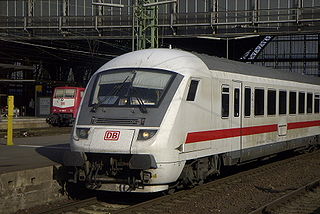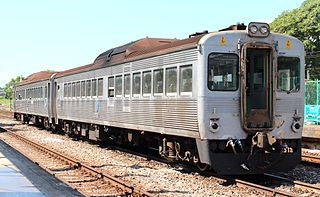
A diesel multiple unit or DMU is a multiple-unit train powered by on-board diesel engines. A DMU requires no separate locomotive, as the engines are incorporated into one or more of the carriages. Diesel-powered single-unit railcars are also generally classed as DMUs. Diesel-powered units may be further classified by their transmission type: diesel–mechanical DMMU, diesel–hydraulic DHMU, or diesel–electric DEMU.

The InterCity 125 (originally Inter-City 125) or High Speed Train (HST) is a diesel-powered high-speed passenger train built by British Rail Engineering Limited between 1975 and 1982. A total of 95 sets were produced, each comprising two Class 43 power cars, one at each end, and a rake of seven or eight Mark 3 coaches. The name is derived from its top operational speed of 125 mph (201 km/h). At times, the sets have been classified as British Rail Classes 253, 254 and 255.

The Mark 2 family of railway carriages are British Rail's second design of carriages. They were built by British Rail workshops between 1964 and 1975 and were of steel construction.

The Budd Rail Diesel Car (RDC), also known as the Budd car or Buddliner, is a self-propelled diesel multiple unit (DMU) railcar. Between 1949 and 1962, 398 RDCs were built by the Budd Company of Philadelphia, Pennsylvania, United States. The cars were primarily adopted for passenger service in rural areas with low traffic density or in short-haul commuter service, and were less expensive to operate in this context than a traditional diesel locomotive-drawn train with coaches. The cars could be used singly or coupled together in train sets and controlled from the cab of the front unit. The RDC was one of the few DMU trains to achieve commercial success in North America. RDC trains were an early example of self-contained diesel multiple unit trains, an arrangement now in common use by railways all over the world.

The British Rail Class 201 six-car diesel-electric multiple units (DEMUs) were built in 1957–1958 at Eastleigh and underframes were built at Ashford.
Push–pull is a configuration for locomotive-hauled trains, allowing them to be driven from either end of the train, whether having a locomotive at each end or not.

The British Rail Class 126 diesel multiple unit was built by BR Swindon Works in 1959/60 to work services from Glasgow to Ayrshire and comprised 22 3-car sets and were a development of the earlier Swindon-built trainsets that had been introduced in 1955 to work the Edinburgh Waverley - Glasgow Queen St services. These vehicles formed the first Inter City service to be operated by diesel units in Great Britain.

A control car, cab car, control trailer, or driving trailer is a non-powered rail vehicle from which a train can be operated. As dedicated vehicles or regular passenger cars, they have one or two driver compartments with all the controls and gauges required to remotely operate the locomotive, including exterior locomotive equipment such as horns, bells, ploughs, and lights. They also have communications and safety systems such as GSM-R or European Train Control System (ETCS). Control cars enable push-pull operation when located on the end of a train opposite its locomotive by allowing the train to reverse direction at a terminus without moving the locomotive or turning the train around.

Nippon Sharyo, Ltd. , formed in 1896, is a major rolling stock manufacturer based in Nagoya, Japan. In 1996, it abbreviated its name to "日本車両" Nippon Sharyō. Its shortest abbreviation is Nissha "日車". It was a listed company on Nikkei 225 until 2004. It is listed on the Tokyo Stock Exchange and Nagoya Stock Exchange as ticker 7102. In 2008, Central Japan Railway Company became the majority shareholder (50.1%) of the financially struggling Nippon Sharyo making the firm a "consolidated subsidiary" of JR Central. In July 2012 Nippon Sharyo USA started production in their new facility in Rochelle, Illinois. The facility closed at the end of October 2018 due to a lack of orders.
The railways of New South Wales, Australia, use a large variety of passenger and freight rolling stock. The first railway in Sydney was opened in 1855 between Sydney and Granville, now a suburb of Sydney but then a major agricultural centre. The railway formed the basis of the New South Wales Government Railways. Passenger and freight services were operated from the beginning. By 1880, there was a half hourly service to Homebush.
Tze-Chiang, also Tzu-chiang or Ziqiang, is a type of limited express train service operated by Taiwan Railway (TR). Of the five service classes operated by TR, the Tze-Chiang service is the fastest. Ticketing is done on the basis of mileage.

The 900/800 class railcars were diesel multiple units built by the New South Wales Government Railways between November 1951 and November 1960.

The Córas Iompair Éireann (CIÉ) 2600 Class were Associated Equipment Company (AEC)–engined diesel multiple units that operated InterCity and suburban services on the CIÉ system between 1952 and 1975. Many were later converted for push–pull operation with diesel locomotives, finally being withdrawn when displaced by the electric Dublin Area Rapid Transit service in the mid-1980s.

Diesel multiple units and railcars are trains, usually with passenger accommodation, that do not require a locomotive. Railcars can be single cars, while in multiple units cars are marshalled together with a driving position either end. As of December 2010, 23 percent of the rail passenger cars used on Network Rail are part of a diesel multiple unit.

The Taiwan Railway EMU100 series was a set of rail cars fabricated by British Rail Engineering Limited and the General Electric Company in 1976 that has operated in Taiwan. The alternating current electric multiple unit (EMU) fleet entered full squadron service in 1979, and was withdrawn from service in 2009. This class of railcars were the first to operate on the electric Tzu-Chiang Express. Due to the unit's British origin, rail buffs have variously nicknamed them "British Girl", "British Lady", or "British Grandma".

The DR2700 series, also locally affectionately known as the "White Steel Train", was a series of diesel multiple unit trains used by the Taiwan Railways Administration. They were originally built by Tokyu Car Corporation of Japan in 1966, in response to an order by the Taiwan Railways Administration, because of the need to renew the rolling stock on the by then 10-year-old Flying Formosan Express service.

Taiwan Railway (TR) is a state-owned conventional railway in Taiwan. It is operated by the Taiwan Railway Corporation under the supervision of the Ministry of Transportation and Communications, responsible for managing, maintaining, and running conventional passenger and freight railway services on 1,097 km (682 mi) of track in Taiwan. Passenger traffic in 2018 was 231,267,955.

The DR2800 series is a series of diesel multiple unit trains operated by the Taiwan Railways Administration as Tze-chiang limited express on non-electrified mainlines. They were originally built by Tokyu Car Corporation of Japan in 1982 for the Taiwan Railways Administration to provide better service on the eastern mainline of Taiwan.

The EMU1200 series is a series of electric multiple unit passenger trains operated by Taiwan Railways Administration (TRA). The train was originally known as the EMU200 series until all of its cars were refurbished between 2002 and 2004. It is one of the trains that are used for the Tze-Chiang Limited Express.

The Taiwan Railway DR1000 gasoline railcar is a railcar used by the Taiwan Railways Administration. This article describes the first generation of the DR1000 units, and also describes the 18DR1010 railcar.

















